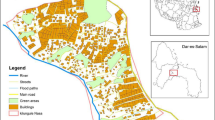Abstract
On the night of 27 February 2010, at 3:34 am, Chileans were gently sleeping in their homes, when suddenly everything was shattered by tremors and destruction, all leading toward a human tragedy. An 8.8-magnitude earthquake struck the country, toppling buildings and driving thousands first into the streets and later to emergency shelters. The earthquake, the sixth largest ever recorded, triggered the second largest tsunami in the country´s history, which ripped houses off their footings, wiped out the urban fabric and turned buildings into debris, leaving behind massive destruction. Some 24 towns and cities were flooded either on or near the shoreline and 800 km of coastline were heavily impacted by the tsunami; nature’s powerful one-two punch killed 524 people and changed the lives of millions. Having observed these violent effects and changes, it could be possible to diminish impacts by educating and warning the population that is exposed to risk. To do so, risk maps should be made and risk management programmes implemented. Creating resilient communities must be a priority, in addition to making them aware of future events, but also emphasis must be placed on the recovery of a sense of belonging with a more comprehensive urban design.














Similar content being viewed by others
References
Alvarez, G et al (2010) Zonas oscuras en el sistema de alarma de advertencia de tsunami en Chile, Santiago
Baeriswyl, S. (2015) Resiliencia urbana; aprender a habitar con las amenazas de la naturaleza, Revista Márgenes, Universidad de Valparaíso, No 15
Cartes, I. (2011) “Plan Maestro de Reconstrucción de Dichato”, in Revista Arquitecturas del Sur, no 39, Universidad del Bío-Bío, Concepcion, pp. 38–51
Cartes, I. (2013) The Reconstruction process of coastal cities in the north of Biobío region”, in (ed) Cardenas, L. The Chilean Eartquake and Tsunami 2010, Wit Press, pp. 105–131
FEMA. (2008) Guidelines for Design of Structures for Vertical Evacuation from Tsunamis. Federal Emergency Management Agency: Redwood City, California
INE. (2010) www.inebiobio.cl Informe de cartografia de daños, accessed 22th March 2010
MINVU. (2010) Plan de Reconstrucción MINVU: Chile Unido Reconstruye mejor, Vivienda Barrio, Ciudad. Agosto 2010.
OGUC. (2010) Ordenanza General de Urbanismo y Construcciones, Ministerio de Vivienda y Urbanismo, Art. 2.1.17., Santiago
Pelling, M. (2003) The Vulnerability of Cities: Natural Disasters and Social Resilience. Routledge: Earthscan
PRBC 18. (2010) Levantamiento de daños evento 12th de Marzo, Plan de Reconstrucción del Borde Costero, Gobierno Regional del Biobío, pp. 1–58.
Recupera Chile. (2014) Recupera Chile Projects and initiatives, www.recuperachile.com, accessed 15 November 2015
Rodríguez, W. (2010) Por una coexistencia responsable con los peligros naturales, Sevilla
Santibanez, L. (2011) Inversiones en emprendimientos productivos en Dichato, Diario de Concepcion, 27th July, p. 3
UC. (2010) Definición de áreas de peligro de tsunami diferenciado, Pontificia Universidad Católica de Chile, Instituto de Geografía, September, pp. 1–37.
UNESCO. (2009) Aprendizaje y adaptación a tsunamis a nivel comunitario en Colombia, Ecuador, Perú y Chile, Comisión Intergubernamental Oceanográfica de la UNESCO, Santiago.
Walker, R. et al (2013), Instrumentos de Planificacion y Gestion Territorial, Centro de Estudios de Reconstruccion, Ministerio de Vivienda y Urbanismo, MINVU, Santiago
Author information
Authors and Affiliations
Corresponding author
Rights and permissions
About this article
Cite this article
Cartes, I. Disaster recovery and place-led development through comprehensive urban design. Urban Des Int 23, 54–63 (2018). https://doi.org/10.1057/s41289-016-0018-4
Published:
Issue Date:
DOI: https://doi.org/10.1057/s41289-016-0018-4




